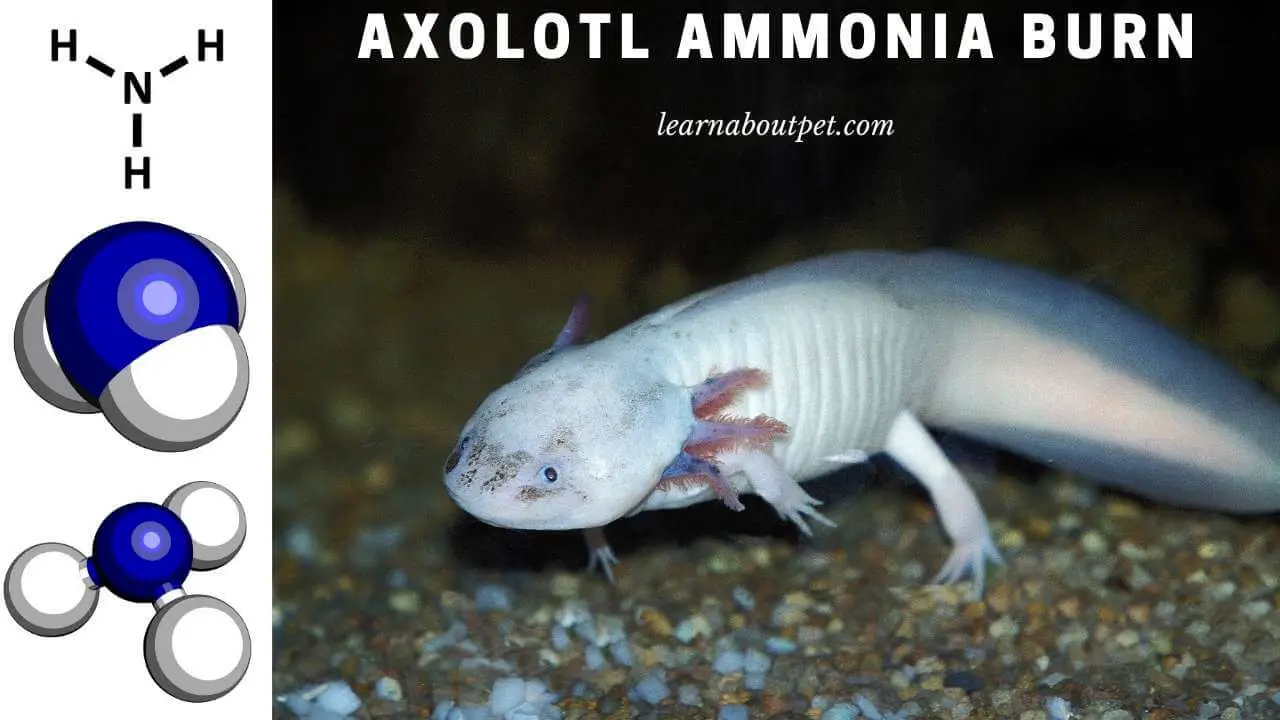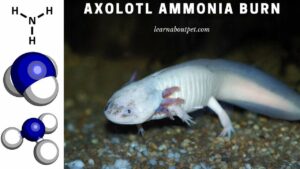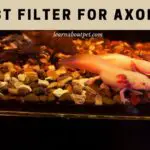Having an axolotl as an aquatic pet is challenging because to keep them healthy and not stressed, they must meet several criteria, especially the water parameters. If there is a problem with one of the water parameters, such as temperature, ammonia, or nitrite levels, it can affect the axolotl. The thing that often happens when new owners take care of axolotls is axolotl ammonia spike in the tank.
Do you see Axolotl ammonia burn in your pet? Nitrite and ammonia levels must be at 0 ppm because more than that will be toxic to axolotls. The ammonia burn occurs because the owner uses a non-cycled aquarium or a cycle crash occurs. The condition of the axolotl when exposed to ammonia burn is redness all over its body, and the gill filaments are like burning. You need to give treatment and cycle the tank as fast as possible.

To find out in detail, why axolotl must avoid ammonia to be healthy and free from burns, you need to read this article to the end.
Is .25 Ammonia Safe For Axolotls?
Any ammonia above 0.25 can be toxic to axolotls, so you should always check ammonia and nitrites levels at 0 ppm. If ammonia is at 0.25, immediately change the water and check using a water test kit to ensure the ammonia level has decreased, so it is safe for your axolotl.
The axolotl way to keep ammonia down is by water changes and cleaning the axolotl dirt in the tank. In addition, there are uneaten food or dead plants that can increase the ammonia level.
If the ammonia level is allowed to continue to rise, it will cause axolotl ammonia burn and cause the axolotl’s body to become red and fraying of gill filaments.
Ammonia is not safe for the axolotl. Besides that, the axolotl is also an aquatic pet sensitive to water quality in the tank. If axolotls feel the ammonia level is increasing, they will show it through their behavior.
How Much Ammonia Is Toxic To Axolotls?
Ammonia levels are already dangerous, even above 0.25. If the ammonia level exceeds one ppm, then the axolotl can be exposed to health risk and possibly get axolotl ammonia burn.
Checking ammonia and nitrite levels must be done regularly because axolotls can change their behavior immediately if ammonia starts to spike. They will have less appetite, float and can be exposed to ammonia poisoning at a certain level.
If you have cycled the tank before, then the next step is to do a regular water test at least once a week if you use a water filter and once every two days if you don’t use a filter.
Cleaning the tank regularly will ensure that dirt, food debris, and plants are kept clean, so ammonia levels stay at 0 ppm.
If you don’t have much time to often clean the axolotl tank, use a water filter from an old tank that already has beneficial bacteria to go cycling faster, and the nitrogen cycle is complete.
How Do I Lower The Ammonia In My Axolotl Tank?
If you want to lower your ammonia level so you don’t get axolotl ammonia burn, you can always check the tank’s condition to be free of axolotl’s waste and algae. If the tank has a lot of algae, the ammonia will rise faster, and the axolotl will be stressed.
Axolotl ammonia spike can be seen if the axolotl has started to float and refuses food. Immediately check the water parameters and immediately do a water change between 20-30% to immediately decrease the ammonia level.
Live plants can also help your tank so that there is no sudden increase in ammonia level, but make sure the plants are always healthy without any decay.
What Is The pH Level For Axolotls?
The ideal water pH for axolotl tanks is 7.4-7.6. If you want to fill water for the axolotl tank, don’t use tap water because it has a lot of chlorine and chloramines, which are harmful to the axolotl.
If you want to have an axolotl using chemical to bring down ammonia, do not put the axolotl in the tank until the process of lowering the ammonia level is complete. If the axolotl is in a tank that contains chemicals, they are afraid that it will have a side effect on their health.
You can use fresh water to reduce the ammonia level when doing a water change, but not more than 50%, so that the axolotl is not stressed by the new water conditions in the tank.
To check whether the pH level is by the axolotl’s needs, you should not put the axolotl for 24 hours after placing the dechlorinated water in the tank. If the ammonia level is at 0 ppm, your pet will avoid axolotl ammonia burn.
What Causes Ammonia In Axolotl Tank?
To prevent axolotl ammonia poisoning in your tank, you can check the water level every day and immediately clean the tank if it looks dirty. The table below is the main cause of rising ammonia levels in your axolotl tank.
| Ammonia problem | Explanation |
| Axolotl’s waste | Axolotls are animals that produce a lot of waste. If it is not cleaned immediately, the waste will increase the ammonia level. |
| Dead plants | If you put plants that can’t stand cool temperatures and die quickly due to lack of sunlight, then decaying plants will cause high ammonia levels. |
| Uneaten food | If axolotl food is not eaten and allowed to sink in a tank, foods such as worms or crustaceans will decay and produce ammonia. |
You have to understand the axolotl ammonia burn rate, and your axolotl will be suffering because of this condition. Don’t let your tank get dirty with leftover food or axolotl poop, and do a water change once a week.
How Do You Treat Ammonia Burns On Axolotl?
You can treat axolotl ammonia burn by putting tea leaves or almond leaves into the tank to prevent infection even though the axolotl’s body has started to turn red. This is to prevent more severe injuries due to high ammonia levels.
You do not need to panic when axolotl ammonia burn occurs, and do not immediately give a salt bath because it can cause the infection to get worse.
A good axolotl ammonia burn treatment is a tea bath because it is safer for axolotl skin affected by burning and repeats for a few days until the axolotl condition improves. If it does not improve, immediately take the axolotl to the vet.
Instead of waiting until the axolotl is exposed to ammonia burn, you should prevent that from happening by checking the ammonia and nitrite levels using a water test kit as often as possible because axolotls are sensitive animals with poor water conditions.

How Do You Treat Ammonia Poisoning In Axolotls?
Transfer the axolotl to another tank with the right temperature and water according to the required water parameters, then change the water in the tank with a high ammonia level until the ammonia decreases.
Axolotls should not be fed immediately because they must adapt to a new place and be free from ammonia or nitrites. If the axolotl has started to move, as usual, you can feed them so that their condition recovers.
If you have been exposed to axolotl ammonia burn, you can give a tea bath and let the effect run until the axolotl ammonia burn scale decreases slowly.
Repeat the tea bath until the axolotl’s color is no longer red, and their body’s regeneration process also helps heal faster. If it is healthy, axolotl gills will grow back to normal.
As axolotl ammonia burn relief, don’t let your tank experience the same condition so that the axolotl can be calm in the tank without having to be exposed to ammonia poisoning or ammonia burn a second time.
Axolotl Ammonia Burn Medicine
If you can take the axolotl to the vet, you can ask if there is any special medicine to quickly improve the axolotl’s condition. If the axolotl can be given antibiotics or antiseptics to heal the body affected by axolotl ammonia burn, they will also recover faster.
Axolotl with ammonia burn can be given almond leaves into the tank or tea bath before being put back in the tank with normal ammonia and nitrite levels. Almond leaves can also reduce burning symptoms while helping the axolotl condition better.
If the vet gives a special medicine, make sure they give it through a syringe-like when you force them to eat so that the medicine process can also work faster in their bodies.
Do not immediately enter the axolotl in the same tank, but check it first until you ensure the ammonia level is at 0 ppm.
How To Prevent Axolotl Ammonia Burn And Stress?
Axolotls can be stressed by many things, such as being overcrowded, constipation, bad water conditions, and being disturbed by other axolotls. In contrast to ammonia burn, the obvious cause is high ammonia from food residue or axolotl poop that is not cleaned.
You can reduce stress on axolotls by changing 20-30% water and can be checked for ammonia levels until they decrease. Do not let the tank’s temperature also rise after changing the water because the cause of axolotl stress is because the temperature rises dramatically.
You can do axolotl ammonia burn prevention by cleaning the axolotl waste quickly before a day passes and waiting a while to immediately clean the uneaten food, so it doesn’t rot in the tank.
Take better care of your axolotl from experiencing ammonia burn because it can shorten their life expectancy and make it easier for the axolotl to get more severe infections.
Axolotl Ammonia Burn Symptoms
It starts with less appetite when the axolotl starts to feel the ammonia level in the tank rises. You won’t be aware of this, because maybe the axolotl is just eating less than usual and you think that’s normal.
Furthermore, the axolotl will float more often because it is not comfortable with the water conditions in the tank.
If left for a few days, the axolotl’s body will start to turn red like bruises, and the gills will burn and disappear slowly. Axolotls will be less responsive, and their bodies will start to turn red all over.
If it is severe, you need to ask the vet if there is an axolotl ammonia burn cream that can be applied to the axolotl’s body or made to take a bath so that their body condition can recover quickly.
The axolotl’s body’s condition will worsen if you keep the ammonia level in the tank high. You can put the axolotls in another tank with an ammonia level of 0 ppm and give them a tea bath until they recover.
Final Verdict – Axolotl Ammonia Burn
Keeping water parameters good is the duty of axolotl owners to live up to their life expectancy. Ammonia levels can rise due to things like food scraps, axolotl poop, and dead plants. You can put plants resistant to cold temperatures and only need a little light to keep growing.

Keeping the tank clean, such as cleaning the axolotl poop immediately after it comes out and changing the water regularly, will lower the ammonia level.
Always check using a water test kit and make sure the ammonia or nitrites are at 0 ppm. If it is more than 0.25 ppm, immediately change the 20-30% water and double-check to ensure the ammonia level has decreased.
Do not expose axolotls to ammonia burn, reducing their life expectancy and becoming susceptible to infection if left for too long.

Welcome to Learn About Pet. My name is Rajkumar Ravichandran and I love all pets, travel, and amazing food. I write about my passion and personal experience caring for multiple pets in this blog! ❤️
Post Disclaimer
DISCLAIMER: THIS BLOG OR WEBSITE, "Learn About Pet", DOES NOT PROVIDE YOU WITH MEDICAL ADVICE AND IS NOT A SUBSTITUTE FOR MEDICAL ADVICE. ALWAYS GET IN TOUCH WITH YOUR PERSONAL VETERINARIAN AND USE INFORMATION HERE AS GENERAL ADVICE.
The information, including but not limited to, text, graphics, images and other material contained on this website are for informational purposes only. No material on this site is intended to be a substitute for professional veterinary advice, food recommendation, diagnosis, or treatment. Always seek the advice of your veterinarian or other qualified health care provider with any questions you may have regarding a medical condition or for pet food related questions.







